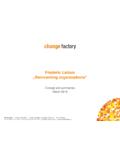Transcription of VIEWS FROM INSIDE AND OUTSIDE: INTEGRATING EMIC …
1 ^ Academy ol Maaagem nt Review1999, Vol. 24. No. FROM INSIDE AND OUTSIDE: INTEGRATING EMIC AND ETIC INSIGHTSABOUT CULTURE AND lUSTICE JUDGMENTMICHAEL W. MORRISS tanford UniversityKWOK LEUNGC hinese University of Hong KongDANIEL AMESU niversity of California at BerkeleyBRIAN LICKELU niversity of California at Santa BarbaraWe analyze forms ol synergy between emic and etic approaches to research on cultureand cognition. Drawing on the justice judgment literature, we describe dynamicsthrough which the two approaches stimulate each other's progress.
2 Moreover, wedelineate ways in which integrative emic/etic Irameworks overcome limitations ofnarrower frameworks in modeling culture and cognition. Finally, we identify advan-tages of integrative frameworks in guiding responses to the diverse justice sensitiv-ities in international the study of cognition in organizations, andin social science more broadly, there are twolong-standing approaches to understanding therole of culture: (1) the INSIDE perspective of eth-nographers, who strive to describe a particularculture in its own terms, and (2) the outside per-spective of comparativist researchers, who at-tempt to describe differences across cultures interms of a general, external standard.
3 Pike (1967)designates these approaches the emic and eticperspectives, respectively, by analogy to twoapproaches to language: phonemic analysis ofthe units of meaning, which reveals the uniquestructure of a particular language, and phoneticanalysis of units of sound, which affords com-parisons among languages. The emic and eticperspectives are often seen as being atodds as incommensurable paradigms. In thisarticle we argue that these two approaches toculture are complementary.
4 Drawing on the jus-tice judgment literature, we delineate forms ofsynergy between the two research perspectivesthat go beyond those identified previously ( ,Berry, 1990; Brett, Tinsley, lanssens, Barsness, &Lytle, 1997). We first analyze ways in which emicand etic research programs have stimulatedeach other's progress. Then we analyze advan-tages of frameworks INTEGRATING emic and eticaccounts both as middle-range theories of cul-ture and cognition and as applied guides toresponding to diverse justice concerns in inter-national AND ETIC PERSPECTIVESThe emic and etic perspectives have equallylong pedigrees in social science.
5 The emic orinside perspective follows in the tradition ofpsychological studies of folk beliefs (Wundt,1888) and in cultural anthropologists' striving tounderstand culture from "the native's point ofview" (Malinowski, 1922). The etic or outside per-spective follows in the tradition of behavioristpsychology (Skinner, 1938) and anthropologicalapproaches that link cultural practices to exter-nal, antecedent factors, such as economic orecological conditions, that may not be salient tocultural insiders (Harris, 1979).
6 The divide between these two approachespersists in contemporary scholarship on culture:in anthropology, between interpretivists (Geertz,1976, 1983) and comparativists (Munroe & Mun-roe, 1991), and in psychology, between culturalpsychologists (Shweder, 1991) and cross-cultural781782 Academy oi Management ReviewOctoberpsychologists (Smith & Bond, 1998). In the liter-ature on international differences in organiza-tions, the divide is manifest in the contrast be-tween classic studies based on fieldwork in asingle culture (Rohlen, 1974), as opposed to sur-veys across many {Hofstede, 1980).}
7 Likewise, inthe large body of literature on organizationalculture, there is a divide between researchersemploying ethnographic methods (Gregory,1983; Van Maanen, 1988) and those who favorcomparative survey research (Schneider, 1990).The conceptual assumptions with which Pike(1967) defined the emic and etic dichotomy aresummarized in Table 1. Emic accounts describethoughts and actions primarily in terms of theactors' self-understanding terms that are oftenculturally and historically bound.
8 For example,emic studies of justice perceptions in NorthAmerican organizations today might center onsuch constructs as "age-ism" and nondiscrlmi-nation, whereas studies of Japanese workplacesmight be couched in qualitatively different con-structs, such as amae and gimu (see Kashima &Callan, 1998). In contrast, etic models describephenomena in constructs that apply across cul-tures. For example, a country's level on the cul-tural dimension of individualism-collectivismmight be linked to the prevalence with whichmanagers reason about justice in terms of theequity rule ( , rewards received should be pro-portional to contributions).
9 Along with differing constructs, emic and eticresearchers tend to have differing assumptionsabout culture. Emic researchers tend to assumethat a culture is best understood as an intercon-nected whole or system, whereas etic research-ers are more likely to isolate particular compo-nents of culture and state hypotheses abouttheir distinct antecedents and consequences. Al-though, of course, the emic/etic contrast is, inpractice, a continuum, this dichotomy hasplayed a central role in the metatheory debatesin many social science disciplines (see Head-land, Pike, & Harris, 1990).
10 '' Some scholars have used the terms emic and etic inways that depart irom Pike's definitions (see Headland et ). A narrower usage refers to the contrast between cul-ture-specific versus culture-general constructs. This missesthe essence of the distinction, because culture-specific con-structs do not necessarily resonate with cultural insiders'self-understandings, A broader usage refers to the underly-ing interests of understanding versus control (Habermas,Etic and emic approaches traditionally havebeen associated with differing research meth-ods.)












